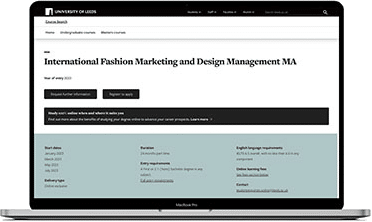Social Media Marketing for Fashion Brands: How to Create a Winning Strategy
International Fashion Marketing
From showcasing the latest styles on Instagram to monitoring the newest trends on Twitter, social media marketing offers a crucial way for fashion brands to engage with customers.
In this blog, we explore the unique landscape of social media marketing for fashion brands and highlight some winning examples of brands doing it well on an international scale.
Learn more about our International Fashion Marketing and Design Management courseWhy do international fashion brands need social media strategies?
Social media campaigns sprung to prominence as a key marketing strategy for international fashion brands in the late 2000s, and channels such as Facebook, Instagram, Twitter and YouTube continue to be a key driver of brand awareness, website referrals and sales today. While they are congested channels filled with adverts from a host of retailers, social media remains highly valuable and should play a central role in your digital marketing strategies.
How do fashion marketing managers use social media successfully?
Fashion marketers create winning social media strategies in a variety of ways depending on their commercial interests. However, they channels are typically used to:
- Understand the changing demands of the industry globally (e.g., sustainability) through social listening
- Monitor the latest international fashion trends by geography and audience
- Build brand awareness and customer loyalty in key markets
- Visually showcase their products (e.g., modelling pictures)
- Ensure that advertising campaigns are resonating with global audiences
- Share company updates, new releases, events, and other information
- Collaborate with worldwide partners, sponsors, and influencers to reach different audiences
- Produce paid adverts for new ranges or campaigns
- Drive website traffic
- Engage with customers by reacting to community generated content
- Answer customer service queries through social media messaging platforms
Key considerations for fashion social media campaigns
The opportunities offered by social media marketing for fashion brands are far-reaching and can have a positive impact on business performance. If you’re looking to develop a successful social media strategy, it’s more complex than simply posting content and hoping that it hits home with your target audience. You’ll need a put a strategy into action to help you meet your goals.
Here are some of the main things to consider when building a social media marketing strategy:
1. Audience targeting and platform mix
It’s a fact that customers of fashion products are on social media; the challenge is finding where they are and reaching them. So, rather than posting endlessly on social media, establish the exact channels that your customers use and interact with.
Most social media channels have information on their users such as age, gender and interests, which they can use to help brands target prospective customers with their ads. They can even tell you who has visited your website or engaged in the past and are therefore more likely to make a purchase.
Once these audiences have been identified, figure out a winning platform mix and decide which channels to use for which purpose. For example, if you are posting a long infographic, you may not have the same impact on Instagram as you would on Pinterest due to real estate. Alongside this, it’s crucial to build an audience across your own social media channels which can be used to share products and messages to those with a keen interest in the brand.
2. Influencer marketing
Influencer marketing uses endorsements and product mentions from celebrities or ‘influencers’ in a certain niche, to cross-promote fashion products to a wider online audience. This digital marketing strategy works because of the trust influencers have with their following, who in turn will trust their recommendations.
Investment in influencer marketing is anticipated to grow by 35% by 2027, and will be particularly beneficial if you are looking to reach new audiences and gain valuable endorsements. In fashion, you can seek out influencers to trial, wear and recommend new lines of clothing, directing a new audience to your fashion products.
While paid celebrity influencers offer huge audiences to international brands, the cost can be extremely high. As a result, consider opting for smaller ‘micro-influencers’ with fashion expertise to spread your global message on a local scale. Although their followings typically have a smaller and more local audience, micro-influencers are seen to be more authentic and relatable, meaning their audience are more likely to act after viewing their posts, driving more intentional and cost-effective engagement to your brand.
Case study – eBay
In 2022, the UK series of the popular dating programme Love Island switched to a more sustainably driven sponsorship with leading resale site eBay, who use social media marketing to show product placement. eBay benefit from sharing sponsored posts to Love Island’s 3.5 million Instagram followers, while continuing to leverage influencer marketing by having contestants wear their products across a range of social media channels, generating interest and increasing sales.
While it’s too early to judge the results of eBay’s sponsorship, the power of clothing sponsorship has proved invaluable to previous fashion brands. Former sponsor Missguided reported a 40% increase in sales between 7pm and midnight on days the show aired, while 2019 sponsors I Saw It First experienced a 254% increase in Instagram followers after using Love Island contestants to promote their clothes on the show.
3. Ad creative
Another necessity for fashion brands is to get creative with content ideas. Once the best channels for your audiences have been identified, tailor your social media efforts by designing unique advertising creatives that will draw users in.
Case study – Ted Baker
International clothing retailer Ted Baker is well-known for its use of distinctive patterns and colours – a visual style they also used when advertising their 2018 autumn and winter collection. Their series of 10-second Instagram Stories featured new clothing ranges, as well as floral patterns, bright colours, exotic animals, and kaleidoscopic visuals and were then targeted at those who had visited Ted Baker’s website in the past. This unique and bold advertising creative not only reinforced their brand identity, it also drove an 8.2-point lift in ad recall, a 3-point lift in consideration and a 22% increase in website conversions.
4. Community-generated content
Community-generated content is marketing activity created by members of a brand’s online community. Similarly, to ‘micro-influencers’, this content can spread global messages locally and are viewed as highly authentic and valuable with the bonus of being low cost. The creation of community-generated content is typically driven by people’s passion for the brand, so encourage this by running competitions or incentives for customers to share and engage on social media.
Case study – Vinted
Vinted is an online marketplace where members buy, sell and swap pre-loved clothes to a community of online shoppers. Rather than focusing their time and efforts into their own corporate channels, their social media marketing relies heavily on encouraging community generated content ideas from their customers. This word-of-mouth approach has led to over 1.2 billion views of videos listed under #Vinted on TikTok with people showing off their new purchases or advertising their listings.
Similarly, their audience in France created a ‘Best of Vinted’ account which highlights the lighter side of the platform’s listings including live demonstrations of ballet clothes being sold and modelling appearances from notable Shrek characters.
Although Vinted are unable to truly analyse the impact that community generated social media content is having on sales, this has clearly benefited the brand with regards to exposure and reach, as they’ve built a customer base of over 65 million and have an estimated worth of $4.5billion.
Study International Fashion Marketing and Design Management with the University of Leeds
Our online International Fashion Marketing and Design Management Masters is a great way to take the next step in your fashion management career. Our module in Social Media Marketing and Communication will not only develop your awareness and knowledge of key concepts in digital marketing, but also its application in the fashion industry. You’ll analyse existing fashion social media campaigns and practice designing a marketing campaign to build an in-depth knowledge of the subject.
Tell Your Story Through Fashion with an online Masters in fashion from the University of Leeds.

Did you enjoy this blog? Here’s some related fashion management content that you may be interested in:

Want to learn more about our online International Fashion Marketing and Design Management course?
Check out the course content and how to apply.

